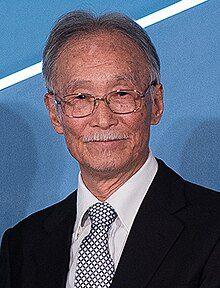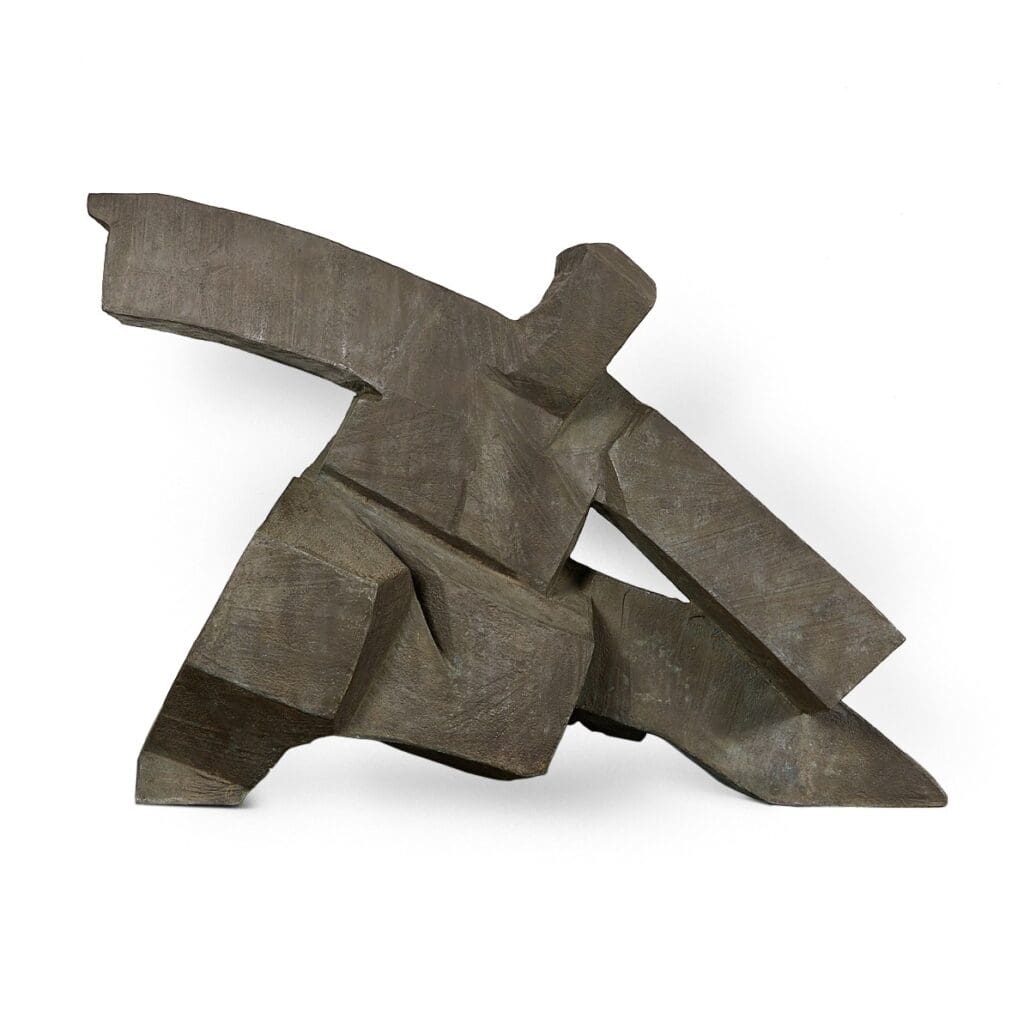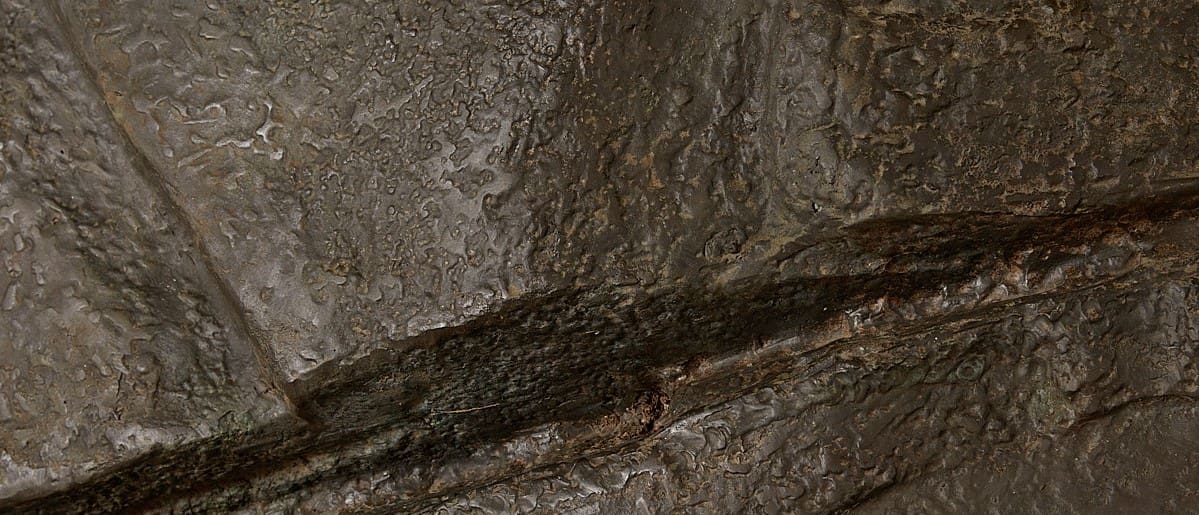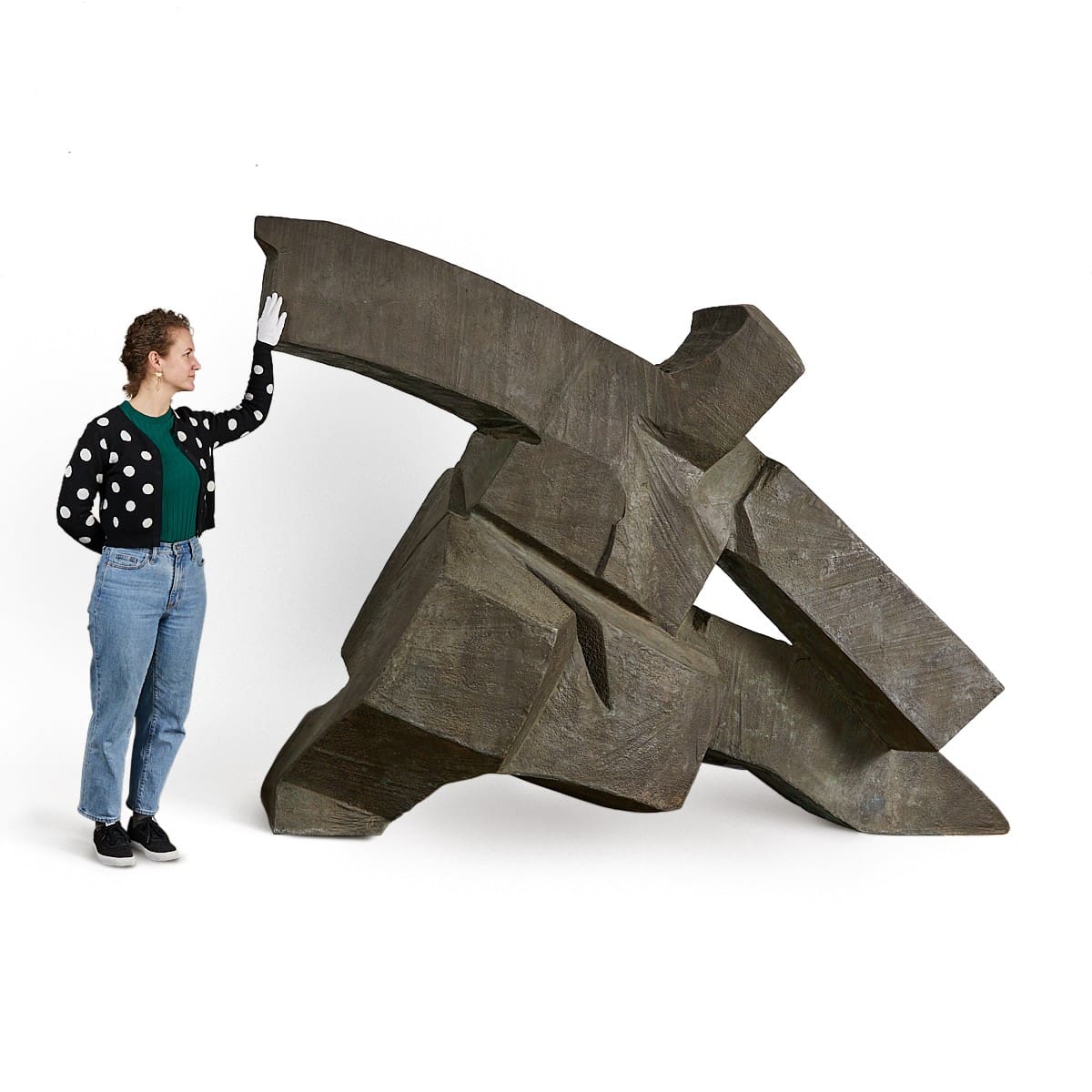
Ju Ming
Taiwanese Artist
1938-2023
Interested in selling a piece by Ju Ming?
We have received top dollar for
Ju Ming works. Auction is the best way to quickly and transparently get maximum dollar for your artwork.

Ju Ming and Single Whip
Ju Ming or Ming Ju (b. 1938) is a Taiwanese artist, best known for his expressionist sculptures, particularly his Tai Chi series. His works celebrate movement, space, and the human experience, using a variety of media in inventive shapes, forms, and a variety of scales to explore humanity’s interaction with the world. He is particularly well known for his Tai Chi series, which celebrates the traditional Chinese sport, an important practice in the artist’s life. Single Whip, an important sculpture from the Tai Chi series, will be up for auction in Revere Auctions’ September sale.
- Biography
- Important Works
- Single Whip
- Selling Ju Ming
Who is Ju Ming?
Ju Ming was born in Tung-Hsiao, Taiwan in 1938. He grew up in a rural environment and only attended school until the age of 13. However, he began his artistic education shortly afterwards. In 1954, his father encouraged him to begin an apprenticeship with wood carver Lee Chin-Chuan of the Temple of the Empress of Heaven in his hometown of Tung-Hsiao. During this three year apprenticeship, Ju became well-versed in traditional sculpture techniques as well as painting. He worked on traditional and religious subject matters as well as assisting Lee with commissions.
In 1959, following the completion of his apprenticeship, Ju started his own wood carving studio, where he trained apprentices of his own. While he earned a steady living through his craft, he found himself wishing for a greater degree of artistic expression. He began experimenting, creating more modern and artistic works. He began achieving success as an artist, participating in competitions and exhibitions and winning several awards at the Taiwan Provincial Art Exhibitions through the mid-1960s.
Deciding he needed more formal training, Ju went on to apprentice with modern sculptor Yuyu Yang (1926-1997) in Taipei from 1968 to 1976. Along with providing artistic training, Yang introduced Ju to the traditional practice of tai chi (t’ai chi), which shifted Ju’s outlook and inspired one of his best known series of sculptures. In March of 1976, Yang helped arrange for Ju’s first solo exhibition, which took place at the Taipei National Museum of History. This exhibition was an enormous success, and led to Ju being titled one of the Ten Outstanding Youths of 1976, a prestigious honor.
The late 1970s and early 1980s were a period of continued success and growth for Ju, during which he had multiple highly acclaimed solo exhibitions throughout Asia. He became a star in the local art scene, and a symbol of Taiwanese pride. In 1981, Ju traveled to New York. There, along with successful exhibitions, Ju began his Living World series, his other best known sculpture series, which launched him into global success.
Ju’s success has continued over the course of the following four decades. He has been the subject of numerous solo exhibitions throughout the world, and his sculptures have been selected for many public venues. He has received many awards and honors, including an Honorary Doctorate from Ju Jen Catholic University in Taipei, and, in 2004, the Lifetime Executive Yuan Cultural Award, which is the highest arts award given in Taiwan, reserved for individuals who have made significant cultural contributions. In 1999, Ju Ming’s museum and sculpture park was opened in Jinshan (Chin-Shan) Taiwan, near Taipei. This museum displays over 1,000 works by the artist and was self-designed. It is the largest outdoor museum in Taiwan, and in 2017 was lauded by the International Council of Museums, the only Asian museum to receive that honor.
When describing his artistic philosophy, Ju said, “Art cannot be learned. The creation of art depends on self-cultivation. What I am most proud of after all these years of artistic creation is not what I have produced, but the concepts I have eventually come to understand. When you study art, you unconsciously absorb the styles and experiences of other people. In the process, you lose yourself, your innate nature. You have to cultivate yourself to find your true self and at the same time discard all your teachers’ genres, so that you can establish a unique style of your own.”

Ju Ming, Single Whip, detail
What is the Artist Ju Ming Known For?
Ju Ming is well-known for his expressionist sculptures. He has a distinct geometric style that blends solid shapes with sharp corners and smooth curves. His sculptures, through varying degrees of abstraction, seek to capture movement and humanity. He has explored these themes through two continuing series, which he has been adding to over the course of several decades.
Tai Chi Series
The first and best known of these series is the Tai Chi series. This was begun in 1976, after Ju took up the practice of tai chi at the urging of his teacher, Yuyu Yang, who felt it would help him gain physical and mental discipline. Tai chi is a traditional Chinese martial art, which generally consists of the solo practice of drills or routines known as taolu. These choreographed forms are often used as a form of meditation and focus on movement and breath. Ju was inspired by his practice of tai chi, and began creating sculptures based on the movements and philosophies of the art.
These works depict abstracted figures in poses based on tai chi. These figures, in bronze, wood, and resin, are rendered in broad, blocky forms with a naturalistic finish. At first glance, the forms appear almost like natural shapes of rock or wood, resolving themselves into humanlike figures on closer inspection. Thus, this series emphasizes the smooth grace of the movements of tai chi. These sculptures arch, curve, and balance; these light movements juxtaposed with the heavy construction creates a powerful impression of freedom as well as groundedness. This innovative series remains Ju’s most popular, consistently commanding the highest prices for his work at auction.
Living World Series
Ju Ming began his Living World series during his early 1980s stay in New York City. He was moved by the mass of humanity that made up the city, and used them as inspiration for his new series. Like the Tai Chi series, these works depict pared-down, minimalist figures, in this case representing the broad range of humans encountered in urban life. They seek to bring out the beauty in the mundane, which people might miss in its unmediated form. As with the Tai Chi series, these works are created from a variety of media, but are often brightly colored and vibrant, like the people they represent. He intentionally keeps these figures anonymous, with highly simplistic and often nearly featureless faces. Ju has created multiple sub-series within the Living World series, including Imprisonment and Ballet among many others, which represent varied facets of the human experience. These sculptures range widely in size, from table-sized to monumental.
What Mediums does Ju Ming Use?
Ju Ming works in many different media. Predominantly a sculptor, Ju works in a variety of metals, including bronze, stainless steel, and copper, as well as wood, ceramic, resin, and even styrofoam. His continuous experimentation with regard to materials has led to a thematically consistent but intriguingly varied body of work. His techniques vary along with his media: his sculptures are cast in different types of molds, as well as hand-sculpted and carved. Along with sculpture, Ju Ming is known for his paintings, which he sees as central to his artistic practice. Quoting his first teacher, Lee Chin-Chuan, Ju has said, “If a sculptor does not know how to paint, it is like an architect who can build houses but does not know how to do blueprint design drawings.” This philosophy is clear in his oeuvre, which remains cohesive even as it is extremely diverse.
The Influence of Artist Ju Ming
Ju Ming’s work has been highly influential. His art is displayed in museums and public spaces worldwide, and has inspired future generations of artists. In addition, his own museum in Taiwan is highly respected and has received great international acclaim. His contributions to arts and culture have resulted in his status as a Taiwanese national hero; so successful was his early career that he became a symbol of the Taiwan Nativist Movement through the 1970s, representing the native talent and culture of Taiwan. His reception of two major arts awards later in his career–the Lifetime Executive Yuan Cultural Award in 2004 and the Fukuoka Asian Culture Prize in 2007–demonstrate the caliber of his importance to the arts.

Single Whip
This monumental cast bronze sculpture from the artist’s Tai Chi series depicts an abstracted figure in a tai chi pose. The blocky limbs are in geometric forms that create smooth lines in space. The figure crouches, low to the ground, on its right leg; the bend of the knee and stomach are formed into squared-off blocks, resembling the strong base of a mountain. The figure’s left leg extends long, forming a gentle slope toward the ground. Its arms spread wide, interposed by a delicate cubic head, overlapping the downward curve of the leg. The overall effect is one of intense juxtapositions: stillness with movement, grace with solidity, lightness with heaviness.
The naturalistic, mountain-like impression of the work is strengthened by the bronze it is cast from. The finish of the bronze is intentionally uneven, creating a rocky effect. The surface ripples and tips under the pleasantly mottled patina, suggesting to the viewer that the figure, already solid and geometric, is a boulder that has slowly awoken to begin graceful movement.
Single Whip is a common posture or movement in tai chi. While its exact form varies depending on the school of tai chi practice, this posture is a central one throughout tai chi, appearing in the most common sequences and serving as the basis for numerous strikes, throws and more in martial versions of tai chi. Importantly, the single whip is often a transitional point, a familiar space that the practitioner moves through in the midst of a sequence. The present work captures this in the way it defies static interpretation. Though cast in a solid piece of bronze, the figure appears to be mid-movement; not frozen, but simply captured in a brief second, arms outstretched, before it shifts to its next posture. The sculpture’s mixture of hard angles and soft lines are intended to mimic the variety in the movements of tai chi. The practice of tai chi is an important part of the artist’s life, and this sculpture is a celebration of that practice, and the way tai chi uses energy to interact with space.
How can I sell my Ju Ming Works?
If you have a Ju Ming sculpture or artwork you are looking to sell, an expert assessment is the best place to start. Our experts at Revere Auctions are ready to help you with any stage of your art journey, whether you are looking for an estimate of value, a USPAP certified appraisal, art restoration, or an effortless way to sell your art. We advertise our sales on more auction platforms than any other auction house in America, and regularly achieve record prices for our objects. If you are interested in selling with us, please get in touch for a free auction estimate.